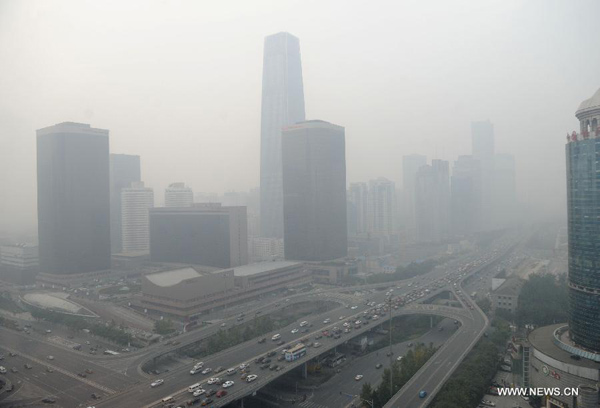

Buildings are blanketed in heavy smog near Guomao Bridge in Beijing, capital of China, Oct. 28, 2013. According to Beijing environment monitoring data, the air quality of central area and southern parts of Beijing is heavily polluted from Sunday night to Monday. (Xinhua/Luo Xiaoguang)
The replacement of coal-powered heating systems with electric and gas-fired versions is expected to bring more breathing space for Beijing residents this winter, a season when they have commonly suffered a recurrent choking smog in the past.
But heating quality will not be compromised even if the city's air pollution is heavy, said an official with the Beijing Municipal Commission of City Administration and Environment during a meeting on Thursday.
A heating plant in a research institute in the city's north has just bid farewell to heaps of coal that used to jam its entrance in winter. Residents of many city-center bungalows no longer face breaking out in a cold sweat over storing enough honeycomb briquettes against winter chills.
"We must complete our work in two weeks before the city's central heating supply kicks off," said Wang Cheng, an official from the State Grid Corporation of China, giving on-site orders in Xi'anfu Hutong for the "coal-to-electricity" project.
This scheme, launched in 2008 by the municipal government, aims to replace coal-burning stoves with electric heaters for residents living in bungalows.
A total of 440,000 such households in downtown areas will be upgraded to electric heating before Nov. 15, according to an action plan of the municipal government.
Over 2,000 workers from the State Grid are currently scattered across the city, busy installing equipment and constructing facilities.
"The room temperature is 10 celsius degrees higher compared with coal heating," said a bungalow resident surnamed Chen, whose indoor heating was upgraded last year.
Tan Daoliang, director of a neighborhood committee in Beijing's Xicheng District, calculated that an ordinary 20-square-meter bungalow needs 1,800 yuan (about 295 U.S. dollars) a year for coal-burning heating, and 1,900 yuan for electric heating.
"Considering the current government subsidies, one only has to pay 1,000 yuan in total for an electric heating season," Tan said.
Besides the financial savings, the removal of coal stoves brings positive effects to the indoor environment, as the hidden hazard of carbon monoxide poisoning is eliminated.
For residents living in other buildings, an ongoing "coal-to-gas" central heating project is also easing their sense of guilt as winter approaches.
A total of 115 boilers in six districts of the city have been upgraded for gas burning, reducing the burning of coal by 600,000 tonnes, according to Liu Wei, deputy director of the atmospheric environment department of the Beijing Municipal Environmental Protection Bureau.
"Over 20 million square meters of floor area or about 200,000 households will be heated by gas-fired thermal power this winter," Liu said.
Three gas-fired boilers in the heating plant in the research institute are undergoing final testing to replace the four coal-fired boilers that have been in service for over two decades.
Cui Liwei, heating branch manager of Beijing Kezhu Property Management Company, said the plant burned 18,000 tonnes of coal every heating season to heat a floor area of less than 800,000 square meters, while the new gas-fired boilers will be able to provide clean heating to 1.3 million square meters of floor area.
According to officials with the Municipal Commission of Development and Reform, Beijing will build four power centers by the end of 2014 to replace coal with natural gas in heating and power generation, which is part of the city's efforts to optimize the energy mix and reduce emissions.
The first phase of a coal gasification project in north China's Inner Mongolia Autonomous Region has also been completed and by the end of December will start to supply Beijing with up to 1.33 billion cubic meters of gas each year.
Upon completion of all three phases next year, the project will be able to supply Beijing with 4 billion cubic meters of natural gas, or nearly half of the current annual gas demand of the capital.
Copyright ©1999-2018
Chinanews.com. All rights reserved.
Reproduction in whole or in part without permission is prohibited.